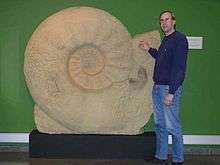Parapuzosia
| Parapuzosia Temporal range: Cenomanian–Campanian[1] | |
|---|---|
 | |
| Parapuzosia seppenradensis with a diameter of 1.8 m (5.9 ft) | |
| Scientific classification | |
| Kingdom: | Animalia |
| Phylum: | Mollusca |
| Class: | Cephalopoda |
| Subclass: | †Ammonoidea |
| Family: | †Desmoceratidae |
| Genus: | †Parapuzosia Nowak, 1913 |
| Species [2] | |
| |
Parapuzosia is an extinct genus of desmoceratid ammonites from the Cenomanian to the Campanian of Africa, Europe, and North America.[2] They are typically very large ammonites, reaching diameters of 60 cm (2.0 ft) or more. It possess a moderately involute shell with flat or slightly rounded sides. Distinct primary and secondary ribbing can be observed in the inner whorls.[3]
Name Origin
The origin of the generic name Parapuzosia ("similar to Puzosia") comes from the smaller, related desmatoceratid Puzosia. "Puzosia" comes from the Serbian words "пужа/Puzo" (Snail) and "Oca/Osia" (Axis), translating to "snail axis".
Species
Species included under Parapuzosia include:
- Parapuzosia americana (Scott & Moore, 1928)
- Parapuzosia boesei (Scott & Moore, 1928)
- Parapuzosia bradyi (Miller & Youngquist, 1946)
- Parapuzosia corbarica (Grossouvre, 1894)
- Parapuzosia seppenradensis (Landois, 1895)
References
- ↑ Sepkoski, Jack (2002). "Sepkoski's Online Genus Database". Retrieved 2014-05-28.
- 1 2 "Paleobiology Database - Parapuzosia". Retrieved 2014-05-28.
- ↑ Neal L. Larson, Steven D. Jorgensen, Robert A. Farrar, & Peter L. Larson (1997). Ammonites and the Other Cephalopods of the Pierre Seaway. Geoscience Press, Inc. p. 44. ISBN 0-945005-34-2.
This article is issued from Wikipedia - version of the Sunday, February 07, 2016. The text is available under the Creative Commons Attribution/Share Alike but additional terms may apply for the media files.